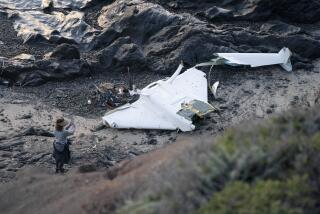Lightweight Plane Star of Design Show : Technology: Neico Aviation’s sleek business aircraft with an all-composite airframe is faster, easier on fuel than similarly priced competition.
- Share via
ANAHEIM — It’s sleeker, lighter and faster.
Known as the Lancair IV, it is a business aircraft designed and marketed by Neico Aviation of Santa Paula.
Its all-composite airframe is faster and 60% more fuel-efficient than those of similarly priced business planes. It can reach a cruising speed of 330 m.p.h. because its fuselage is made of composite carbon fibers--strong as steel but 30% lighter than aluminum.
“It’s the state of the art in the aerospace industry,” said Lance Neibauer, Neico Aviation’s president. “This is the first small plane assembled from a kit that uses an all-composite airframe.”
Because of that, it is the star of the three-day Design Engineering Show and Conference/West that began Monday at the Anaheim Convention Center. With 270 exhibitors, the show features a wide swath of new technologies--from a “guided hammer” that prevents smashed thumbs to a diaper beeper that goes off when a toddler wets.
But the talk of the show was the Lancair IV. Composite materials have been used in military aircraft for decades, but Neibauer said it was only in the past several years that they have become practical for general aviation.
Although Beech Aircraft Corp. in Wichita, Kan., makes an eight-passenger composite aircraft, Neibauer said, the Lancair IV has no direct competitors.
Neibauer, a 40-year-old self-taught aircraft designer, said he spent two years designing the four-seat craft. The company has two other small plane kits on the market--the two-passenger Lancair 320 and a single-passenger, the Lancair 235--but Neibauer said the Lancair IV is the first with an airframe made without heavier fiberglass components.
The Lancair IV airframe kit--without the engine or avionics system--costs $38,500. A fully equipped aircraft would cost $85,000 to $90,000 to assemble. Neibauer said that price compares to $275,000 for business aircraft with similar speeds.
With the more efficient airframe, the twin-engine aircraft has room for a comfortable cabin, Neibauer said. It seats a pilot and three passengers and has room for cargo. It also has minimal drag since the composite materials are held together by epoxy rather than rivets.
Since unveiling the aircraft July 17, Neico has received 26 orders for kits worth about $1 million. The first airframes will be shipped in February, 1991, Neibauer said. The company eventually hopes to make five or six aircraft a month.
Neibauer said Neico has subcontracted manufacturing of the airframes to High-Tech Composites in Oxnard, and it is also arranging to build airframes at a factory in Mexico or the Philippines.
Among other products on display was a guided hammer, the patented brainchild of San Diego physicist Lawrence L. Lee, which promises “no more smashed thumbs!” The hammer looks like a big screwdriver, but the shaft has a hollowed-out slot that holds a nail in place with a magnet.
Using a spring-and-pulley system that multiplies the force of the hammerhead, the user pushes the handle down. That force, in turn, moves a hammer weight attached to the shaft, which strikes the nail with the same force as a hammer, Lee said.
Though the patent was awarded more than three years ago, Lee said, he is still looking for a company to manufacture the hammer.
“I’ve licensed other products, but usually it’s just luck,” he said.
More to Read
Inside the business of entertainment
The Wide Shot brings you news, analysis and insights on everything from streaming wars to production — and what it all means for the future.
You may occasionally receive promotional content from the Los Angeles Times.








